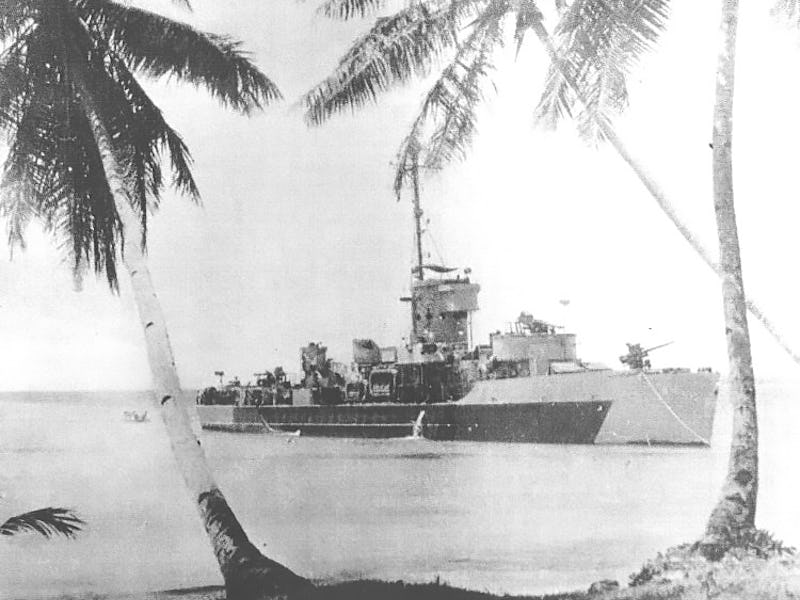Scientists are racing to keep microbes from eating sunken ships
"Shipwrecks act as artificial reefs."

When a ship sinks to the ocean's bottom, it's not the end of the boat's story. Abandoned shipwrecks turn into artificial reefs, populated by marine wildlife and microbes.
One budding microbial community is within the Pappy Lane shipwreck in North Carolina's Pamlico Sound. Some protect the ship from crumbling, while others actively eat its remains. Their identification is key to determining how to safeguard the Pappy Lane for future generations.
In a new study, researchers describe how these distinct microbial communities inhabit different parts of the Pappy Lane shipwreck. They identified 28 types of bacteria in 14 samples, discovering that communities fill specific niches in their micro-marine environments. Some bacteria eat iron, speeding up corrosion, while others form a film that protects the ship from breaking down.
As a result, the Pappy Lane is corroding asymmetrically, with some parts of the ship remaining far more intact than others. The goal, ultimately, is to help preserve the ship for both ecological and cultural reasons, researchers say. That begins with a better understanding of the microbes on board.
The findings were published on Wednesday in the journal Frontiers in Microbiology.
Lost at sea — The Pappy Lane was a steel-hulled warship, built in 1944 during World War II. The 160-foot ship ran aground in the 1960s in the shallow water of North Carolina's Pamlico Sound lagoon. Then it was abandoned — at least, by humans.
After the Pappy Lane sunk, it became part of the ocean ecosystem. No longer manned by a captain and crew, sunken ships turn into artificial reefs, populated by all kinds of fish, oysters, turtles, and, of course, microbes.
Erin Field, an assistant professor of biology at East Carolina University, led the study. The ship-turned-reef is both culturally and ecologically important, Field tells Inverse.
"That wreck doesn't just represent a historical incident or a piece of history," Field says. "It also represents this wonderful place that provides food, provides shelter, and places for organisms to work together."
Pappy Lane sunk after it ran aground in the 1960s.
For people who live in the community near the Pappy Lane wreck, the ship is a landmark. Locals have seen the wreck for decades, visited it, and kayaked out to explore the ship's remains.
"It's a real staple in the community," Field says. Some of the most interesting parts of this research, she says, have been "being able to interact with the community a little bit, and give them some information about the organisms associated with the wreck, [and] what it could mean for bio-corrosion and preservation."
Microbes, good and bad — Field and her team hopes this initial study can help inform better methods of preserving shipwrecks like Pappy Lane. These findings are a step toward grasping "how the community is assembling on that wreck and what it means for corrosion," Field says.
Microbes are the base level of an ecosystem, often the primary producers. They are instrumental in cycling carbon, nitrogen, and other nutrients — and providing food for other organisms in the ecosystem.
By detecting the potential for microbes to cause bio-corrosion, researchers can potentially control microbes' growth, helping with preservation in the long term. In contrast, some microbes that help preserve ships by building a biofilm that guards against seawater corrosion.
"Microbes play a lot of different roles in the artificial reefs," Field says. "Understanding both the good and the bad in what they can do there is really important."
Abstract: Shipwrecks act as artificial reefs and provide a solid surface in aquatic systems for many different forms of life to attach to, especially microbial communities, making them a hotspot of biogeochemical cycling. Depending on the microbial community and surrounding environment, they may either contribute to the wreck’s preservation or deterioration. Even within a single wreck, preservation and deterioration processes may vary, suggesting the microbial community may also vary. This study aimed to identify the differences through widespread sampling of the microbial communities associated with the Pappy Lane shipwreck (NC shipwreck site #PAS0001), a shallow water ferrous-hulled shipwreck in Pamlico Sound, NC to determine if there are differences across the wreck as well as from its surrounding environment. Loose shipwreck debris, drilled shipcores, surrounding sediment, and seawater samples were collected from the Pappy Lane shipwreck to characterize the microbial communities on and around the shipwreck. Results indicated that the shipwreck samples were more similar to each other than the surrounding sediment and aquatic environments suggesting they have made a specialized niche associated with the shipwreck. There were differences between the microbial community across the shipwreck including between visibly corroded and non-corroded shipwreck debris pieces. Relative abundance estimates for neutrophilic iron-oxidizing bacteria (FeOB), one organism that may contribute to deterioration through biocorrosion, revealed they are present across the shipwreck and at highest abundance on the samples containing visible corrosion products. Zetaproteobacteria, a known class of marine iron-oxidizers, were also found in higher abundance on shipwreck samples with visible corrosion. A novel Zetaproteobacteria strain, Mariprofundus ferrooxydans O1, was isolated from one of the shipwreck pieces and its genome analyzed to elucidate the functional potential of the organism. In addition to iron oxidation pathways, the isolate has the genomic potential to perform carbon fixation in both high and low oxygen environments, as well as perform nitrogen fixation, contributing to the overall biogeochemical cycling of nutrients and metals in the shipwreck ecosystem. By understanding the microbial communities associated with shallow water ferrous-hulled shipwrecks, better management strategies and preservation plans can be put into place to preserve these artificial reefs and non-renewable cultural resources.
This article was originally published on